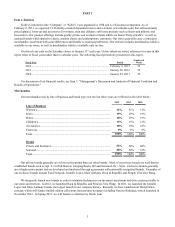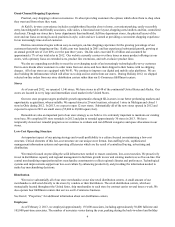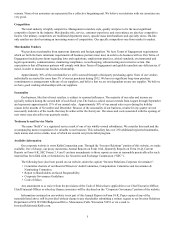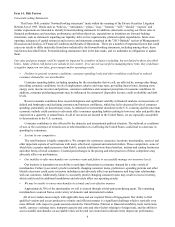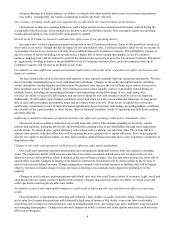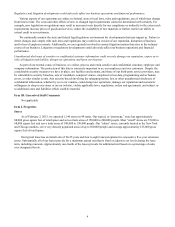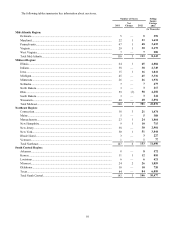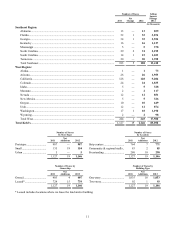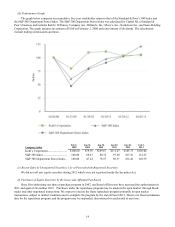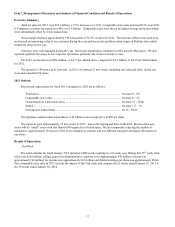Kohl's 2012 Annual Report Download - page 8
Download and view the complete annual report
Please find page 8 of the 2012 Kohl's annual report below. You can navigate through the pages in the report by either clicking on the pages listed below, or by using the keyword search tool below to find specific information within the annual report.8
facing technology in a timely manner, our ability to compete with other retailers and to meet our customer expectations
may suffer. Consequently, our results of operations could be adversely affected.
Our revenues, operating results and cash requirements are affected by the seasonal nature of our business.
Our business is subject to seasonal influences, with a major portion of sales and income historically realized during the
second half of the fiscal year, which includes the back-to-school and holiday seasons. This seasonality causes our operating
results and cash needs to vary considerably from quarter to quarter.
Growth in our E-Commerce business could adversely affect some of our operating metrics.
In recent years, we have experienced significant growth in our E-Commerce business. Some of this growth has resulted in
lower sales in our stores. Though this has no impact on our consolidated sales, it has had a negative effect on our net income as
a percentage of sales as our stores are currently more profitable than our E-Commerce business. This profitability variance is
due to a variety of factors including, but not limited to, a higher mix of lower margin merchandise in our E-Commerce
business, shipping costs, and investments to provide the infrastructure necessary to grow the E-Commerce business. Though we
are aggressively working to improve the profitability of our E-Commerce business, there can be no assurances that our E-
Commerce business will become as profitable as our stores.
Our inability to raise additional capital and maintain bank credit on favorable terms could adversely affect our business and
financial condition.
We have historically relied on the public debt markets to raise capital to partially fund our operations and growth. We have
also historically maintained lines of credit with financial institutions. Changes in the credit and capital markets, including
market disruptions, limited liquidity and interest rate fluctuations, may increase the cost of financing or restrict our access to
these potential sources of future liquidity. Our continued access to these liquidity sources on favorable terms depends on
multiple factors, including our operating performance and maintaining strong debt ratings. If our credit rating were
lowered, our ability to access the debt markets and our cost of funds for new debt issuances could be adversely impacted.
Additionally, if unfavorable capital market conditions exist if and when we were to seek additional financing, we may not be
able to raise sufficient capital on favorable terms and on a timely basis (if at all). If our access to capital were to become
significantly constrained or costs of capital increased significantly due to lowered credit ratings, prevailing industry conditions,
the volatility of the capital markets or other factors, then our financial condition, results of operations and cash flows could be
adversely affected.
Inefficient or ineffective allocation of capital could adversely affect our operating results and/or shareholder value.
Our goal is to invest capital to maximize our overall long-term returns. This includes spending on inventory, capital
projects and expenses, managing debt levels, and periodically returning value to our shareholders through share repurchases
and dividends. To a large degree, capital efficiency reflects how well we manage our other key risks. The actions taken to
address other specific risks may affect how well we manage the more general risk of capital efficiency. If we do not properly
allocate our capital to maximize returns, we may fail to produce optimal financial results and we may experience a reduction in
shareholder value.
Changes in our credit card operations could adversely affect our sales and/or profitability.
Our credit card operations facilitate merchandise sales and generate additional revenue from fees related to extending
credit. The proprietary Kohl's credit card accounts have been sold to an unrelated third-party, but we share in the net risk-
adjusted revenue of the portfolio, which is defined as the sum of finance charges, late fees and other revenue less write-offs of
uncollectible accounts. Changes in funding costs related to interest rate fluctuations will be shared similar to the revenue if
interest rates exceed defined amounts. Though management currently believes that increases in funding costs will be largely
offset by increases in finance charge revenue, increases in funding costs could adversely impact the profitability of this
program.
Changes in credit card use, payment patterns and default rates may also result from a variety of economic, legal, social and
other factors that we cannot control or predict with certainty. Changes that adversely impact our ability to extend credit and
collect payments could negatively affect our results.
An inability to attract and retain quality employees could result in higher payroll costs and adversely affect our operating
results.
Our performance is dependent on attracting and retaining a large number of quality associates. Many of those associates
are in entry level or part-time positions with historically high rates of turnover. Our ability to meet our labor needs while
controlling costs is subject to external factors such as unemployment levels, prevailing wage rates, minimum wage legislation
and changing demographics. Changes that adversely impact our ability to attract and retain quality associates could adversely
affect our performance.



